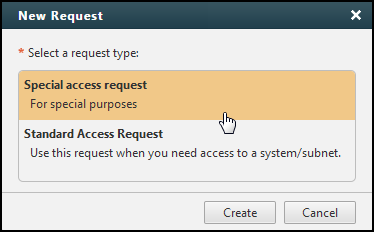On This Page
Creating a Change Request
|
|
This topic is intended for SecureChange requesters, responsible for creating change requests in SecureChange. |
Overview
SecureChange users can open a request when they are associated with roles that have the Create requests permission. Available request types correspond to workflows in which the user is added as a participant in the first step. A user can enter the details for the request or import the request information from a closed ticket.
If email requests have been configured, users can send an email and a request will automatically be created.
Resubmit Existing Requests
To open a new request that is similar to an existing request, you can duplicate an existing request to open a new request. The duplicated request includes all the information that was defined in the original request. Then you can quickly edit some of the details and submit the new request.
-
In My Requests, you can either:
-
Click New Request to define a request from scratch.
-
Select an existing request from the list and click
 to create a duplicated request with the request details from the existing request.
to create a duplicated request with the request details from the existing request.

If the existing request contains fields that do not currently exist in the form (the first step) of the workflow it was created from, these fields are not shown in the new request. Any new fields in the form are included in the new request as blank or with their default values. In this case, you are notified that the new request will use the new form. Click Continue to create the new request.
-
-
If it is a new request, select a request type, select the domain that the ticket should be associated with (if available), and click Create:

In multi-domain mode, if you are in more than one domain you can select the domain that you want to create the request in.

-
Enter the Subject of the request, and select a Priority.

When adding or editing a ticket (via the Requests page or a REST API) the Subject field is validated. If the Subject field is not valid, the ticket cannot be saved.
The Subject field is not validated or changed during or after an upgrade. After an upgrade, when a ticket with an invalid Subject field is resubmitted after the upgrade, the user will not be able to save the ticket.
The following characters are allowed: Characters in all languages, Integers 0–9, Special characters + -_ # @ . , : = ! ^ ( ) and blank spaces.
The Priority field is only available if it was configured in the workflow.
-
If enabled, you can also add a related ticket to the workflow, which can be used for reference purposes.
To add the ticket, click the +Add related ticket link to open a lookup where you can search for related tickets (according to Ticket ID or Subject), and select the related ticket you want to add to the workflow.
-
You can also add an attachment, up to 10MB per file.
The file extensions of attachments that can be uploaded in a SecureChange ticket draft and in the comments section are limited to the following default extensions: txt, pdf, doc, docx, xls, xlsx, ppt, pptx, pps, ppsx, odt, key, zip, jpg, jpeg, png, gif, csv. Files without an extension are valid.
To add other file extensions to the list of allowed extensions, contact Tufin support.
Handlers and requesters can see the attachments in the right side of the task status bar:

-
If the request workflow was configured to enable group notification, you can select a Notification Group from the list of groups of which you are a member.
-
Provide input in the input fields that have been configured for this request type. If one of the fields is an Access Request, enter the requested traffic flow.
-
If you are one of the Participants in the next step, and the step is configured to be Self-Assigned, you can select Assign to myself:

-
Click Submit.
Only the groups with the relevant group permissions and fewer than 100 members are displayed.
After you submit a request, you can view the status of the request or add a comment.
You can view Update, Access Request, or Verify requests in the Rule Viewer in SecureTrack.
